
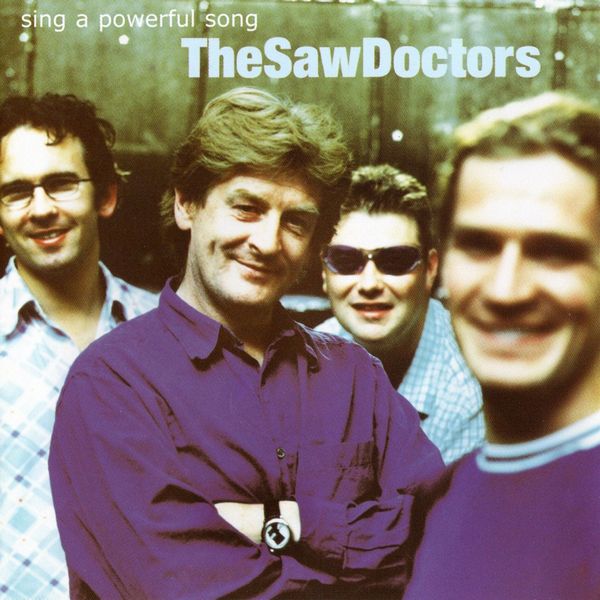 |
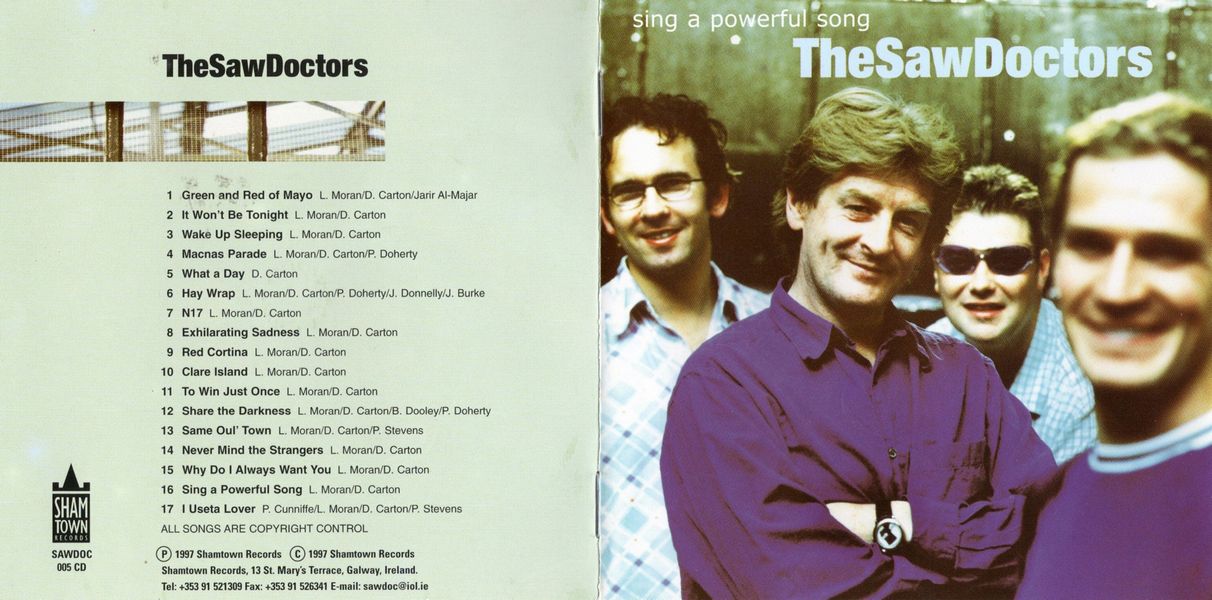
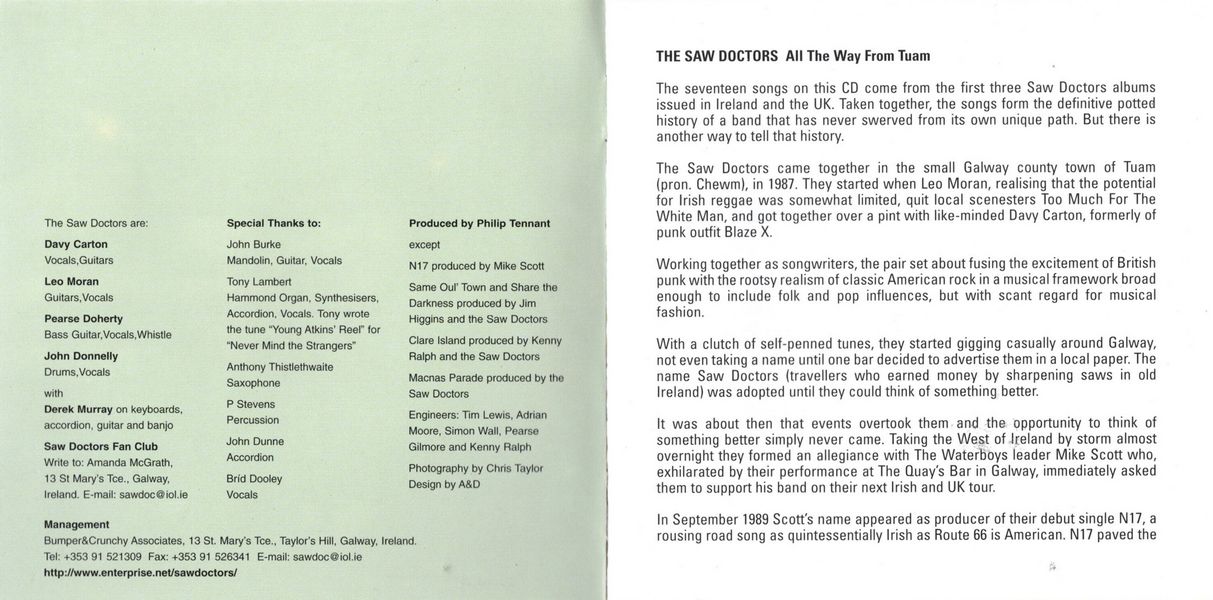 |
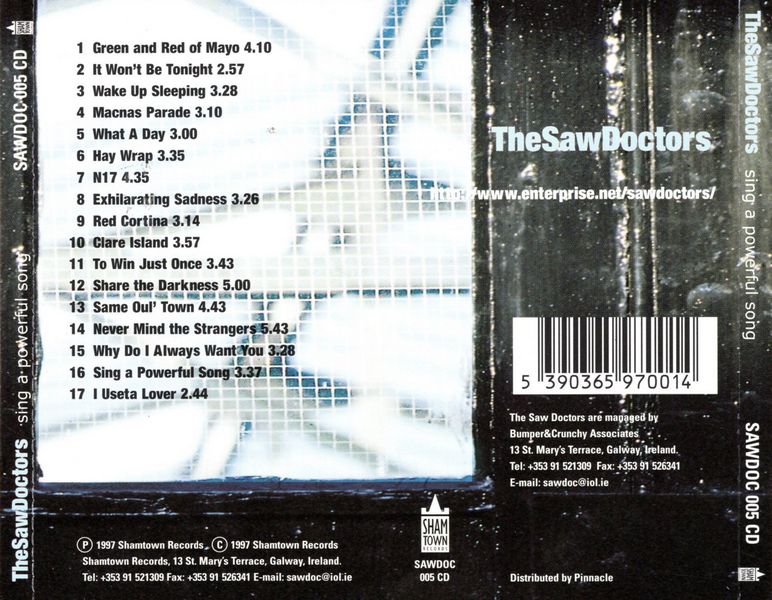
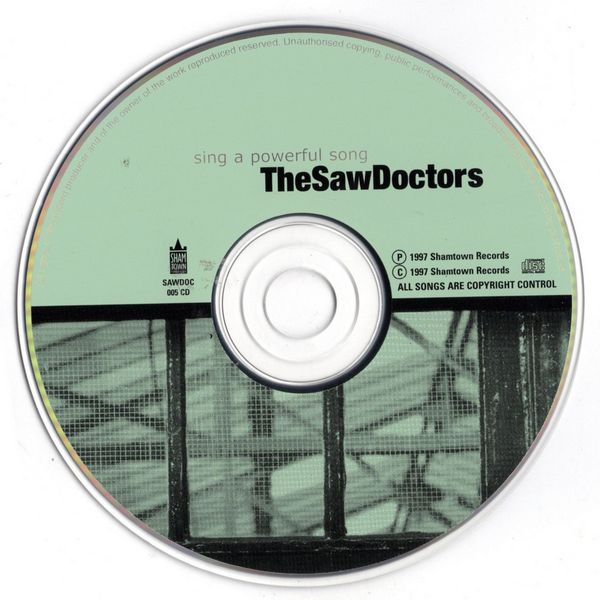 |
| more images |
Sleeve Notes
The Saw Doctors — All The Way From Tuam
The seventeen songs on this CD come from the first three Saw Doctors albums issued in Ireland and the UK. Taken together, the songs form the definitive potted history of a band that has never swerved from its own unique path. But there is another way to tell that history.
The Saw Doctors came together in the small Galway county town of Tuam (pron. Chewm), in 1987. They started when Leo Moran, realising that the potential for Irish reggae was somewhat limited, quit local scenesters Too Much For The White Man, and got together over a pint with like-minded Davy Carton, formerly of punk outfit Blaze X.
Working together as songwriters, the pair set about fusing the excitement of British punk with the rootsy realism of classic American rock in a musical framework broad enough to include folk and pop influences, but with scant regard for musical fashion.
With a clutch of self-penned tunes, they started gigging casually around Galway, not even taking a name until one bar decided to advertise them in a local paper. The name Saw Doctors (travellers who earned money by sharpening saws in old Ireland) was adopted until they could think of something better.
It was about then that events overtook them and the opportunity to think of something better simply never came. Taking the West of Ireland by storm almost overnight they formed an allegiance with The Waterboys leader Mike Scott who, exhilarated by their performance at The Quay's Bar in Galway, immediately asked them to support his band on their next Irish and UK tour.
In September 1989 Scott's name appeared as producer of their debut single N17, a rousing road song as quintessentiay Irish as Route 66 is American. N17 paved the way for their first hit I Useta Lover. For a while it was virtually a second national anthem, dominating the No1 slot in Ireland for 9 weeks and becoming that country's biggest-selling single of all time.
Success, however, came hand in hand with controversy, because the song's lyric soon had Ireland's religious establishment reeling. Set during a Sunday mass where a hot-blooded young buck is more aroused by his beloved's rear view than by the sermon, the song demonstrated that The Saw Doctors were not prepared to compromise when it came to lyrical integrity.
A re-release of N17 at the year's end saw it too soar into the Irish charts with ten times platinum sales, quickly followed in the spring of 1991 by their debut album If This Is Rock and Roll, I Want My Old Job Back which gave them their first No1 in the albums chart.
Here was the point where a wider public was able to discover the songwriting strengths of Leo Moran and Davy Carton. Their unswerving commitment is to the creation of music about the things they understand which, by extension, are also the things that audiences around the world understand. Moran himself offers a more modest explanation of their working method. "From country to punk to pop music, to rock'n'roll we stole all our favourite bits out of that"
Well, maybe, but in a Saw Doctors, song, you'll listen in vain for the usual swaggering rock clichés about life on the road, drug problems and easy sex. Instead, continuing a tradition that echoes the greats like Woody Guthrie and Hank Williams, you get songs that range from bringing in the harvest, to running away to join the army; from the plight of Ireland's unmarried mothers to the effect of strong religion on a nation's youth; from playing Gaelic football against a neighbouring village to loving the prettiest girl in town but lacking the courage to tell her.
You'll also find a whole new language. Words like sham (a good friend) and smokies (travellers), are just two examples of unfamiliar terms which are liberally sprinkled through Saw Doctors lyrics but, as Leo Moran points out, "When I think back on all my favourite music, there were always references to things I didn't fully understand, but you get a sense that they're real and authentic" He's right. The average Irish kid getting into rock'n'roll has always been mystified by references to mojos, hi-heeled sneakers and woodies in American hit tunes, but the music still communicates its meaning.
The summer of 1991 was spent playing festivals, followed by the band's first brief but successful American jaunt in the autumn. They returned home to find themselves not only voted Best New Band at the Irish Entertainment Awards but also, and this is unprecedented for a band so new, the subject of a Channel 4 TV documentary entitled Sing A Powerful Song.
A second American tour followed in the spring of 1992. "The full house cheered, " reported The New York Times, of their Big Apple gig that May, going on to note that, "It was only the group's first song; fans jumped up and down, climbed on shoulders and collided with one another, slam-reeling."
The Saw Doctors returned home to start work on a second album. Everything so far had been achieved on the Irish independent label, Solid, but it now seemed vital, if the band was to achieve its full potential in other countries, to hook up with a bigger label.
Not surprisingly, considering their Irish achievements, several major companies had been monitoring their progress so, when their second album All The Way From Tuam, appeared in October 1992, it boasted a WEA label and secured their first UK Top 40 entry.
It's well worth taking a closer look at how at least one song from that album came into being. "Hay Wrap wasn't written, " says Moran. "It was collected. All we had to do was listen." What they were listening to was the conversation of farm workers baling hay during the harvest. "The rhythm of the song isn't far from the rhythm of the baling machine, and the chorus is what the lads shout while they're working"
"Something I like about that song is the repeats in the verses, " adds Davy Carton. "A baling machine, you see, is so loud you have to shout to be heard. So you might say I'd kill for a pint of porter, but then you'd have to repeat it louder because your mate didn't catch what you said" That's just one song, but the same authenticity and attention to detail is there in everything they write.
1993 was a year of consolidation, as the Saw Doctors toured extensively across Britan, Europe and Australia in support of the album. By now, the media was beginning to grasp the appeal of the band. "There is a special place in rock'n'roll mythology, " wrote David Sinclair of The Times, "for that rare phenomenon, the people's band. The Grateful Dead, The Faces and Bruce Springsteen during his years as leader of the E Street Band are examples which define the breed; the Saw Doctors are the latest in this strangely noble line."
Sinclair also noted that the band's appeal was not only across the board, but also in defiance of all the rules that normally apply to rock success stories in the 1990s. "They are not loud, angry or vigorously uncompromising. They have no message or attitude and, given their origins in the rural wilds of Tuam, County Galway, street credibility is not even on the cards"
Fortunately, the only credibility that matters to the Saw Doctors is the kind conferred on them by the people for whom they sing and play. Buoyed by the success of the second album, but now keen to resume control of their own affairs, the band formed its own label, Sham Town, and while working on their third album, released the Small Bit Of Love EP, which delivered their first UK singles chart Top Thirty entry during November 1994, and their first appearance on Top Of The Pops. The year ended with the high of another sold out UK tour.
More American dates followed early in 1995, including the South By Southwest Festival in Austin, Texas, which found the band in its element. Over the previous couple of years their reputation at British and European festivals, including Glastonbury, had become second to none. This status was more than ever in evidence in June when they headlined London's Fleadh, along with Van Morrison and Sinéad O'Connor.
Their next single, World Of Good, bettered the Small Bit Of Love EP by taking them into the UK Top Twenty, swiftly followed by a No6 position for the third album, Same Oul' Town, supported by, yes, another sell out UK tour.
When that one rollercoastered into London, in March 1996, it was another reviewer for The Times, Paul Sexton, who observed that "if they could bottle the sort of bonhomie that can make an entire concert hall feel better, the Saw Doctors would have the medicine show to end them all" Following a UK Top Twenty smash with To Win Just Once, and the usual swathe of festivals, the band took a well-earned break towards the end of 1996, the first in their ten year history.
With their remarkable level of success, it would have surprised no-one if the Saw Doctors had re-located to London or at least Dublin, but that seems to be the last thing on their minds. After their fourth, most extensive and successful US visit ended in June 1997, they returned to Galway to continue work on their fourth album with long-time collaborator and songwriter Padraig Stevens and it seems impossible that 1998 can bring anything but the continuation of their slow, steady climb to international acclaim.
Over the years, the roster of those who could call themselves Saw Doctors has changed from time to time, but the core of the band, almost from the start, has remained Davy Carton (vocals/guitar), Leo Moran (guitar/vocals), Pearse Donnelly (bass/vocals/flute/tin whistle) and John Donnelly (drums). These are the people who define the band and, as Sid Griffin of Q magazine has observed "The Saw Doctors are the very definition of the people's band"
In Ireland's rich musical history, there have been bands more successful than the Saw Doctors, U2 being perhaps the most obvious example. It's hard, however, to think of a band so beloved by its audience. It's also hard to find another band that has played in convents, on near-deserted islands, and in the front room of one of their most devoted fans.
To put it simply, the Saw Doctors are more honest to God real than almost any other rock band on the planet. Hell, it's hard to think of another band that even comes close.
Johnny Black
October 1997